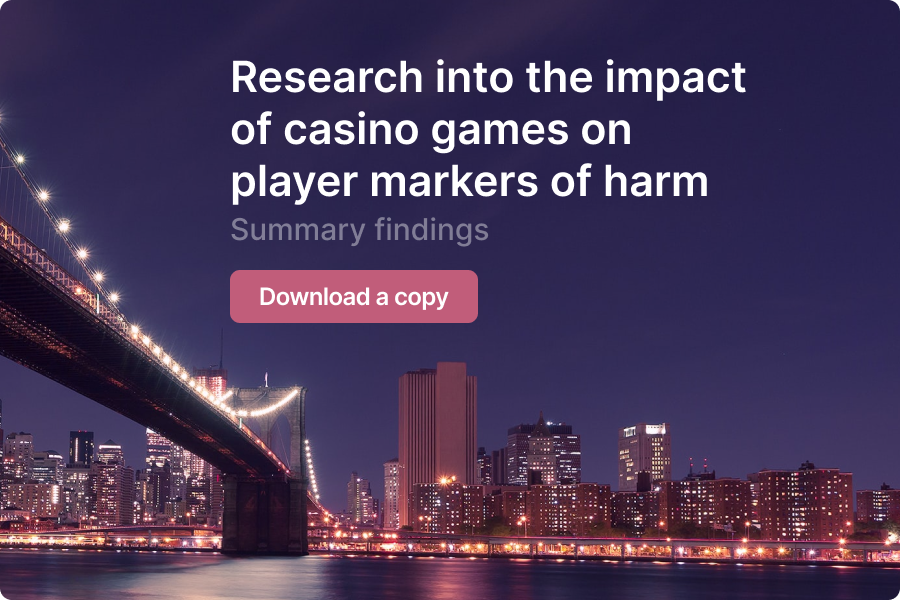We are passionate about data and its power to facilitate change; to grow revenues, to design better games and create personalised experiences for specific players and crucially, to analyse risk versus games and drive safer, sustainable play.
All of this lies within your data, and you might not even know it.
Our AI-driven platform, products and toolkits have, so far, analysed 35 billion spins from some of the industry’s most well-known operators and studios. To coincide with Safer Gambling Week, we took this to the next level partnering with leading operator Gamesys modelling 36 million gaming sessions across 368 games to research the impact of casino games on markers of harm.
The results (download the full report here) discovered there is no statistically significant correlation between player markers of harm and three game characteristics: Volatility; Return to Player (RTP); Hit Rate.
Below are our five data-driven responsible gaming tips every operator and studio should follow:
1. Be extra vigilant monitoring early morning sessions
It often assumed that overnight play may be more prone to risk, however little research has been published in this area. Our modelling found sessions from 12 to 6am were 36% riskier than other times of the day.
2. Be aware that once a player has one high-risk session, they are seven times more likely to have another high-risk session compared to a player who has just had a safe session
Our research looked at how players transition between the risk sessions and the probability of a player moving and staying on a risk label.
In more detail, more than 9% of high monitor players continued to be in this ‘monitor cluster’ in their next session with 1.1% going onto the high-risk cluster in their next session, and nearly 4% high risk players remaining in the high-risk cluster in their next session.
While there were some games that were more likely to have player transitioning from one risk category to another, there was no pattern or shared characteristic among them that correlated with risky play.
3. There are specific games which, overall, tend to have a higher prevalence of risk occur on them – be aware of these games and try to understand why this is the case
Despite no correlation found between markers and harm and game components, we discovered examples of specific games that had a larger probability of risk occurring. While this could be due to a multitude of reasons such as promotional activity, acquisition offers, risk scoring games in this manner could be used to recommend games that are less likely to display markers of harm to players who are showing early signs of risky play.
4. Monitor players who drastically change playing behaviour i.e., large increase in usual max stake or sessions much longer than average
While it may initially seem counterintuitive that a game measure, such as volatility, is not correlated with increased player risk, it conforms to the body of research on markers of harm, which conclude player behaviours and players exhibiting markers of harm can occur on any game.
It is therefore always best practice to monitor players who suddenly change their gameplay behaviour such as large swings in average stake or sessions that drastically exceed their average session times.
5. Send risk scores back to game studios to investigate what features may drive risky play
Improve customer experience by risk scoring your players and sharing this information with your studio partners. This will give you a view of which of your players are at risk and those regularly displaying high levels of risk. This data-driven approach will enable you to find out:
- how many risky sessions occur across your portfolio and how this changes over time
- what a ‘risky session’ looks like with staking behaviour graphed for easy review
- ‘explainability’ of what markers of harm occur within these risky sessions
- how many and which one hour-plus sessions are displaying markers of harm
- the times and days when risky sessions occur
- risk prevalence by game
Take the next step on your data journey
At Future Anthem we are committed to improving the player experience for everyone and from this research we want to empower YOU to take the next step on your data journey. This is why we have pledged to score up to two billion bets so you can risk-assess your players and games with participating operators and studios included in our next RG research initiative upon request.
Start your Safer Play journey today and discover the science of the possible.
Register your interest and one of our Game Data Science experts will be in touch shortly.


